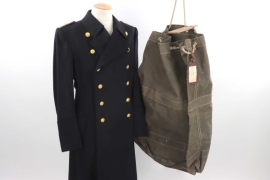61st Contemporary History Auction
Jetzt Vorgebote abgeben | Live-Auktion am 19. und 20. September
-
Bezahlung
-
WIE KANN ICH FÜR MEINE BESTELLUNG BEZAHLEN?
AUKTIONAlle erfolgreichen Gebote werden automatisch zu einer einzigen Bestellung zusammengefasst. Für diese können Sie uns nach Auktionsende in Ihrem persönlichen Kundenkonto Ihre bevorzugte Bezahl- und Versandart oder eine alternative Lieferadresse mitteilen.
Wenn wir diese freiwilligen Angaben nicht von Ihnen erhalten melden wir uns automatisch im Laufe des Montags nach Auktionsende mit einer Zahlungsanweisung per Email. Basierend auf Erfahrungswerten schlagen wir Ihnen die bequemste Bezahlmehtode und die günstigste Versandart vor. Sie möchten Ihre Bezahl- und Versandart ändern oder eine alternative Lieferadresse angeben? Kein Problem! Besuchen Sie Kundenkonto/BESTELLUNGEN oder kontaktieren Sie uns per Email.
BESTELLUNGEN IM ONLINESHOPWählen Sie während der Bestellung Ihre bevorzugte Bezahl- und Versandart und schicken Sie diese ab. Sie erhalten Ihre Zahlungsanweisung spätestens am darauffolgenden Tag per Email. Die Zahlungsfrist beträgt sieben Tage. Sie planen eine Bestellung per Ratenzahlung zu begleichen? Bitte sprechen Sie uns gerne vor Ihrer Bestellung darauf an.
Für mehr Informationen zu Bezahlung und Versand, besuchen Sie unsere Häufigen Fragen.
WIR AKZEPTIEREN FOLGENDE BEZAHLARTEN
-
-
Versand
-
IHRE BESTELLUNG IN DEN BESTEN HÄNDEN
VERPACKUNG & SENDUNGSVERFOLGUNGNach Zahlungseingang versenden wir Ihre Bestellung für gewöhnlich am darauffolgenden Werktag. Wir bestätigen den Eingang Ihrer Zahlung per Email und informieren Sie zur Versandvorbereitung. Nach Abholung der Sendung durch unsere Versanddienstleister teilen wir Ihnen die Sendungsnummer per Email mit. Den Status Ihrer Sendung können Sie auch jederzeit unter Kundenkonto/BESTELLUNGEN einsehen. Ihre Rechnung geht Ihnen automatisch am Tag des Versands zu.
VERSAND ZU EINER ALTERNATIVEN ADRESSEBevorzugen Sie für eine Bestellung einen Versand zu Ihrer Arbeitsstelle? Sie sind im Urlaub und wünschen den Versand zu einer Packstation oder einem Freund? Kein Problem! Diese Änderungen können Sie jederzeit unter Kundenkonto/BESTELLUNGEN vornehmen. Alternativ können Sie natürlich jederzeit auch per Email informieren.
UNSERE PARTNER FÜR DEN VERSAND
-
-
Garantie
-
 GARANTIE!
GARANTIE!Alle angebotenen Artikel werden von unseren Experten akribisch auf deren Echtheit geprüft und detailiert beschrieben. Wir bieten ausschließen zeitgenössiche Originale an. Etwa 15% aller Kundeneinlieferungen ensprechen unseren Anforderungen nicht und werden retourniert.
Gekauft wie gesehen? Nicht bei uns. Im Gegensatz zu traditionellen Auktionshäusern bieten wir volles Rückgaberecht of Originalität an. Sollten Sie mit Ihrer Bestellung nicht zufrieden sein, können Sie die Bestellung innerhalb 14 Tagen widerrufen. Bitte kontaktieren Sie uns vor dem Rückversand. Für mehr Einzelheiten besuchen Sie bitte unsere häufigen Fragen.
In eigener Sache: Bieten Sie nur auf Lose, die Sie auch erwerben möchten. Bitte vermeiden Sie Gebote nach Auktionende zu stornieren. Sollten Sie ein fehlerhaftes Gebot abgegeben haben, informieren Sie uns bitte umgehend. Wir löschen Ihre Gebote gerne bis 24 Stunden vor Ende der Auktion.
-
Land Deutsches Reich 1918 - 1945
Maße
Gewicht
EAN 2000000879536
Epoche 1918 — 1945
Land Deutsches Reich 1918 - 1945
Material
Maße
Hersteller Wilhelm Deumer
Gewicht
Land Deutsches Reich 1918 - 1945
Los 76-1453
Maße
EAN 2000000879536
Hersteller Wilhelm Deumer
Gewicht
Deutsches Reich 1918 - 1945
U-458 Kptlt. Kurt Diggins - 1939 Eisernes Kreuz 1. Klasse "Deumer"
Beschreibung
All items from the estate of Lieutenant Commander Kurt Diggins (Crew 34). Diggins sunk two ships and had seven patrols. He is known (postwar) for a very famous propaganda photo you can find here: https://uboat.net/men/commanders/205.html
Kurt Diggins was born on October 17, 1913, in Gut Mohrberg, then part of Kreis Eckernförde in the Prussian Province of Schleswig-Holstein. Today, this area is part of Barkelsby, located in the district of Rendsburg-Eckernförde, in the federal state of Schleswig-Holstein. He passed away at the age of 93 on March 1, 2007, in Bonn, a city in the Cologne administrative district of North Rhine-Westphalia.
Kurt Diggins began his naval career on April 8, 1934, when he entered the Reichsmarine as a naval officer cadet, having previously served as a merchant ship officer (Handelsschiffsoffizier). He was integrated into the "Crew 35." His initial training took place from April to June 1934 at the 2nd Division of the Baltic Sea Ship Training Division in Stralsund. Following his basic training, he underwent shipboard training aboard the sailing training ship Gorch Fock from June to September 1934, and then on the light cruiser Karlsruhe until June 1935.
He completed further officer training at the Naval Academy in Flensburg-Mürwik from June 1935 to March 1936, including a main course for cadets and the final officer’s examination. After completing additional training courses through September 1936, Diggins’ specific activities between October 1936 and April 1939 remain unrecorded. However, by April 1939, he was serving as adjutant aboard the armored cruiser Admiral Graf Spee, a position he held until the ship's loss off Montevideo on December 17, 1939.
Following the loss of the Admiral Graf Spee, Diggins, along with other crew members, was interned in Montevideo, Uruguay, from December 1939 to July 1940. Upon his return to Germany, he was placed at the disposal of the North Sea Station Command. Between September and December 1940, Diggins assumed command of the 6th Minesweeper Flotilla, followed by command of the 5th Minesweeper Flotilla until March 31, 1941.
In April 1941, Diggins began U-boat training at the 1st U-Boat Training Division in Pillau. This was followed by torpedo and communications training in Flensburg-Mürwik, as well as further U-boat training at Neustadt. By October 1941, he had completed his commanding officer training and live firing exercises at the 24th U-Boat Flotilla in Memel.
On November 16, 1941, Diggins began preparations for the construction of U-458 at the 1st Warship Construction Division in Kiel. He assumed command of U-458, a Type VIIC U-boat, on December 12, 1941, and commanded it until August 22, 1943. During his tenure as commander, U-458 undertook several patrols, including missions in the North Atlantic, along the U.S. East Coast, and in the western Mediterranean. Notably, on a patrol from June 21 to August 27, 1942, U-458 sank two ships totaling 7,584 GRT off the coast of Nova Scotia.
U-458 also participated in various operations in the Mediterranean, including engagements near the Algerian coast and south of Sicily. However, on August 22, 1943, U-458 was lost in the Mediterranean southeast of Pantelleria.
Following the loss of his U-boat, Kurt Diggins was taken as a British prisoner of war and was held from August 22, 1943, to September 5, 1947. He was imprisoned in Egypt and later in England at Camp 18, Featherstone Park in Haltwhistle.
Throughout his career, Diggins received several notable awards and honors. On November 10, 1940, he was awarded the Iron Cross 2nd Class, followed by various distinctions, including the War Badge for Minesweepers, Submarine Hunting, and Escort Forces in March 1941, the Fleet War Badge in July 1941, and the U-Boat War Badge in October 1942. In March 1943, he received the Iron Cross 1st Class, and on August 16, 1943, he was honored with the Bronze Medal for Military Valor from Italy.
Kurt Diggins reached the rank of Fähnrich zur See on July 1, 1935, Oberfähnrich zur See on January 1, 1937, Leutnant zur See on April 1, 1937, Oberleutnant zur See on April 1, 1939, and Kapitänleutnant on January 1, 1942. His long and eventful military career saw him serve in various capacities, from command aboard the Admiral Graf Spee to leading U-boat missions across the Atlantic and Mediterranean.
Kurt Diggins lived a long life, passing away on March 1, 2007, in Bonn. His legacy is marked by his service during some of the most challenging naval campaigns of the Second World War.
Directly from the estate of Kurt Diggins comes this Iron Cross 1st Class. Manufactured by W. Deumer from Lüdenscheid and properly maker- marked with the maker's LDO code L/11. Overall in close to mint condition.
Zustand
1
NAME
Orden des Eisernen Kreuzes 1. Klasse
DATUM DER STIFTUNG
1. September 1939 als zweite Stufe des wiederhergestellten Ordens vom Eisernen Kreuz
AUSZEICHNUNGSKRITERIEN
Das Eiserne Kreuz wurde für besondere Tapferkeit im Angesicht des Feindes und für herausragende Verdienste um die Truppenführung verliehen. Die Vergabe einer höheren Stufe erforderte die vorherige Vergabe der nied- rigeren Stufe. Divisionskommandeure waren ermächtigt das Eiserne Kreuz 1. Klasse zu verleihen. Vorräte des Ordens wurden auf Divisionsebene gelagert.
HERSTELLER
Das Eiserne Kreuz 1. Klasse wurde von mindestens 26 Herstellern gefertigt, Varianten innerhalb den einzelnen Firmen nicht eingerechnet. Die Kreuze sind entweder ungestempelt, mit Präsidialkanzlei Nummer (ab Ende 42/ Anfang 43), oder mit LDO-Nummer als Privatkauf gekennzeichnet.
VERLEIHUNGSZAHLEN
Genaue Zahlen sind nicht bekannt, aber die Schätzungen liegen bei 800.000 - 900.000 verliehenen und höchst- wahrscheinlich doppelte Anzahl von hergestellten Exemplaren.
AUSZEICHNUNGSUNTERLAGEN
Die Division stellte die Verleihungsurkunde im Format A5 im Namen des Führers und Oberbefehlshabers der Wehrmacht (ab Mitte 1943 nur noch im Namen des Führers) aus und diese wurde vom Divisionskommandeur unterzeichnet.
TRAGEMETHODE
Das Kreuz wurde an der linken Brusttasche getragen, oberhalb des Verwundetenabzeichens und anderen Kriegsabzeichen.

SIE NEHMEN NUN AN DER LIVE AUKTION TEIL.

AUKTIONSSTART: 20. September UM 14:00 UHR

AUKTIONSSTART: 19. September UM 15:30 UHR







Um Live-Gebote bei unserer Auktion abgeben zu können müssen Sie unsere AGB akzeptieren. Danach können Sie nicht nur Vorgebote abgeben, sondern am Tag der Auktion auch in Echtzeit mitbieten. Jedes Ihrer Live-Gebote ist bindend, kann nicht zurückgezogen werden und zieht bei Zuschlag einen gültigen Kaufvertrag nach sich.
Wir möchten die Gelegenheit ergreifen und Sie auf Grund der sensiblen Thematik erneut auf die strikte Einhaltung von von §86/86a StGB hinzuweisen. Diese haben Sie bereits bei Ihrer Registrierung bestätigt.
Alle angebotenen Sammlerstücke sind ausschließlich historische Originale und werden nur an Sammler, Museen und Historiker verkauft. Wir distanzieren uns von jeglicher politischer oder ideologischer Motivation.









